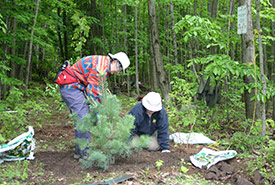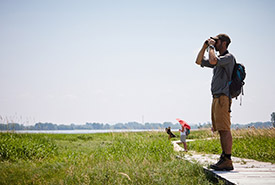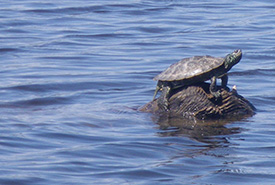Montreal's Greenbelt

Conservation volunteers in the Montreal Greenbelt, Quebec (Photo by NCC)
Did you know that the Nature Conservancy of Canada (NCC) is the largest owner of protected natural environments on private land in Montreal’s greater metropolitan area?
NCC protects 1,700 hectares (4,200 acres) of natural areas in the Montreal metropolitan community. These protected lands can be found on the islands surrounding Montreal, at the foot of the Monteregian Hills, in the peat bogs of the upper St. Lawrence River and in some agricultural lands.
By conserving land in the Montreal and Laval regions, in the south of Lanaudière and the Laurentians, as well as in northern Montérégie, NCC is a key contributor to the establishment of a greenbelt for Greater Montreal.
Halting urban sprawl

Île aux Cerfeuils, Hochelaga Archipelago (Photo by Martin Beaulieu)
The greenbelt concept was originally developed in the United Kingdom in the 1930s, at a time when London was trying to stop urban sprawl. Today, the word "greenbelt" describes a group of protected natural areas that are linked by corridors that have an ecological or recreational function. This allows flora and fauna to move about freely. Given that ecosystems must have adequate links between them in order to ensure the conservation of their biodiversity, the establishment of a greenway network is key to their protection.
In cities boasting greenbelts, such as Toronto and Ottawa, developed and natural areas are integrated. This allows the conservation of biodiversity while also improving air and water quality. People also have increased access to nature.
Remarkable biodiversity

Map turtle (Photo by NCC)
The Greater Montreal greenbelt is made up of an urban area — the most populous in Quebec — as well as peri-urban and agricultural areas.
Despite its mostly urban character, the metropolitan region is home to many natural environments: forests, lakes, islands, riparian areas and wetlands. This territory, which is about 17 per cent covered by forests, contains exceptional ecosystems. It also encompasses many sites of high ecological value in the St. Lawrence lowlands — a testament to the richness of its flora and fauna.
Due to its location and favourable climate, the greenbelt is home to more than half of the province’s vulnerable animal and plant species, including map turtle and lake sturgeon.
By establishing and protecting a large greenbelt in Greater Montreal, we will be able to collectively conserve natural areas and ecosystems for our children and grandchildren. This is exactly what the Plan métropolitain d’aménagement et de développement is proposing with its initiative Trame verte et bleue (French only). This initiative aims to integrate sections of the major Montreal urban area with nature.
NCC now aims to increase the area of protected land in the Montreal greenbelt and continues to support the conservation actions of its partners in the area. Combining awareness-raising with sustainable partnerships will benefit the conservation of natural areas.




